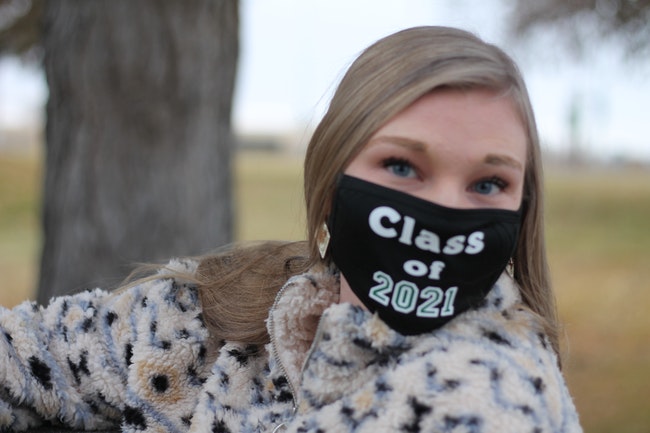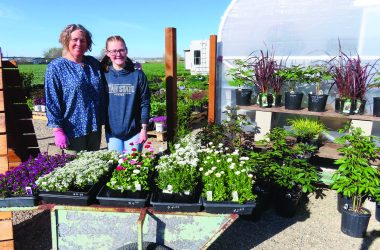
Students like Lizzie Morford are experiencing more anxiety and stress as the pandemic lingers. (The Enterprise/Liliana Frankel).
ADRIAN – When Lizzie Morford, 17, learned in March that her spring break would be extended because of the Covid pandemic, she was excited by the prospect of the extra time off.
She never guessed that she was experiencing the last full-length school days of 2020.
Since then, Covid has worn on, irrevocably disrupting Morford’s senior year at Adrian High School.
“My mental health has just plummeted to the ground,” she said.
She is not alone. The pandemic has deepened life’s challenges for about one out of four school students who already endured mental, social or other problems. In Malheur County, that could mean an estimated 1,000 students or more.
State educators, schools and medical clinics have all adapted to be helpful in a time when the normal day-to-day contact with students is missing.
The impacts aren’t certain yet but are expected to show up in weakened academic performance.
Morford, once motivated to wake up at 6:30 every morning and stay after school through three seasons of sports practice, can now barely muster the energy for her two hours of online classes.
“My anxiety has shot through the roof,” she said. “There’s no social interaction, so you just kind of get depressed and lay in bed all day and not want to move or anything.”
According to Sarah Ludovic-Young, chief quality officer at Valley Family Health Care, the classic problems that teens may face, such as struggles with family, depression, anxiety, self-esteem, and substance use, and trauma, are often aggravated by the pandemic.
Covid, she said, is “a significant stressor.”
For teens, the stresses of Covid, compounded with the stresses of life, are often reflected in their behavior in school.
“One-quarter of students in Oregon have some sort of emotional, social, or behavioral problem, and 70% ask for help in schools,” said Grace Bullock, senior mental health strategist with the Oregon Department of Education. “Schools are really on the frontline of mental health prevention and intervention.”
However, since school in Malheur County has been largely virtual since March, educators have had to get inventive to support students.
“Because we don’t see all of our students face-to-face, I think you have to be more diligent in looking for the things that they’re showing you,” said Stacey Parrish, school counselor at Ontario Middle School. “We always say that all behavior is a form of communication, so if a student’s saying lots of things in the chat box, or not saying a lot of different things, or not participating, or not turning their camera on – that helps us consider what the student is trying to tell us.”
Correctly reading those behaviors can have dizzyingly high stakes.
“Teachers are very sensitive to their students, and they’re well trained on the warning signs of abuse,” said Jennifer Susuki, student wellness coordinator with the Malheur Education Service District, noting that reports of abuse have been down during the pandemic. “A lot of times, it’s just a change in work habits or willingness to speak out in class, so it’s the real subtle differences that it’s hard for teachers to notice when they’re not in the same room.”
As teachers and other school employees work to meaningfully support students, they have new help from the Oregon Department of Education. In December, the agency released a new mental health toolkit and set of web resources. Bullock, who played a central role in designing the toolkit, said that while work on the project had started before the pandemic, Covid “has really accentuated the need for us to provide the resources.”
Strength and equity
A key to the Education Department’s manual is its emphasis on strength rather than weakness, and wellness rather than illness. Bullock explained that much of the stigma around mental health arises from linking illness to weakness. The toolkit casts mental health as something that everyone has, and aims to normalize the feelings of sadness, anger and anxiety which have become so common as students isolate.
“When we focus our attention on trauma and trying to fix what’s broken, that’s a much more deficit-based mindset from which to do the work,” Bullock said. “We’re really trying to switch the conversation to be what are people’s ways of knowing and their ways of being that help contribute to their resilience and mental health.”
In Morford’s case, school sports were a constant until pandemic restrictions ended play. In the absence of the social and physical growth that Morford describes feeling as an athlete, she’s struggled.
But she has continued to rely on physical activity as a coping mechanism.
“I tried out yoga and that was really helpful, so I’ve been keeping up with yoga and just going on runs just to get everything out of my head,” she said. “Just to relax.”
Bullock said that for some people, this kind of self-care might be enough. For others, more structured intervention might be necessary, which is why the state’s toolkit promotes a “tiered” approach.
Its other guiding principles are recognizing traumatic stress, elevating student voices, attending to racial equity and anti-racism, and promoting inclusive school environments.
The commitment made to racial equity, anti-racism, and inclusivity has significant implications for students of color, said Janice Castellón, youth mentor coordinator with the Immigrant and Refugee Community Organization.
“Even if it’s just microaggressions, it still affects people if it happens on a daily basis,” she said. “Hopefully there will be more help or support when it comes to that for the students.”
What’s being done?
According to Parrish, the biggest challenge students tend to face in the pandemic is isolation. “We’ve never spent so much time in our homes and with a limited amount of people,” she said. “We know middle school kids are social being at the core, that’s where they’re at in their development and that peer group is the most important thing to them.”
That’s why at Ontario Middle School, “relationships come before rigor, and connection comes before curriculum,” said Lisa Longoria, principal at Ontario Middle School, describing her staff’s approach to student wellbeing during the pandemic.
She’s not just talking about the relationships between children in their peer groups, but also between children and the adults who care for them.
“There’s a lot of research out there that says if a child has one significant adult out there that they trust, they’ll do a lot better in school and at life in general,” said Susuki.
To help form those connections, Ontario teachers do a Monday morning check-in online with each student, asking how they’re feeling alongside lighter-hearted inquiries about their likes and dislikes, or their successes and challenges.
Morford said that while the staff at Adrian High School have been supportive of students during the pandemic, she wishes that there were those kinds of mandatory check-ins for herself and her peers, so that the burden of asking for help wouldn’t fall on students.
“Obviously no one really wants to be like, ‘I’m struggling, I need help,’” she said. “Me personally, I really don’t like talking about my feelings, so I hardly ever talk to anyone about it.”
Such reticence is one limit that school counselors face. Another is the short-term nature of their work.
“I am one person who has 360 students. I am a great fit for something that can be solved with coping skills, or something that can be done within four to six weeks,” said Parrish. “If it’s a larger issue that’s going to take longer, then I say it’s appropriate for another person to be able to handle that situation.”
Ontario Middle School has a strong community partnership with Lifeways Behavioral Health, where Parrish can refer children who would benefit from a higher level of support.
The Education Department is brainstorming ways to support counselors more as they work to integrate the toolkit’s principles into their everyday practice.
“Right now, since the website has launched, I’ve had a number of districts reach out to me, and we’re doing our best to support them this week with calls and brainstorming sessions, so we will continue to provide that support,” said Bullock. “I think it’s too early to tell if we’re going to be able to do a larger lift until we get considerably more feedback from our community partners.”
Bullock hopes to collect that feedback throughout the coming year, and from a variety of community and educator sources.
News tip? Contact reporter Liliana Frankel at [email protected] or 267-981-5577.
SUPPORT OUR VITAL LOCAL WORK: We provide Malheur County the local journalism that searches out the facts for you. SUBSCRIBE FOR $5/month. Click HERE.




